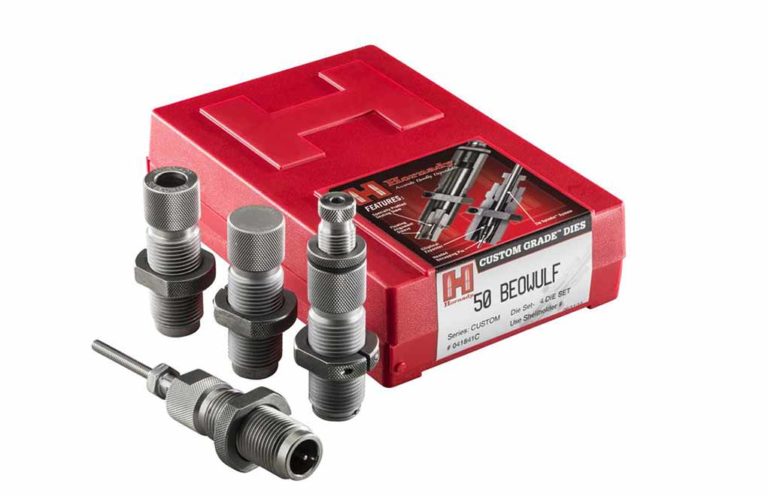
Great cartridges require great reloading dies, here are the best to choose from.
What Are The Top Reloading Dies:
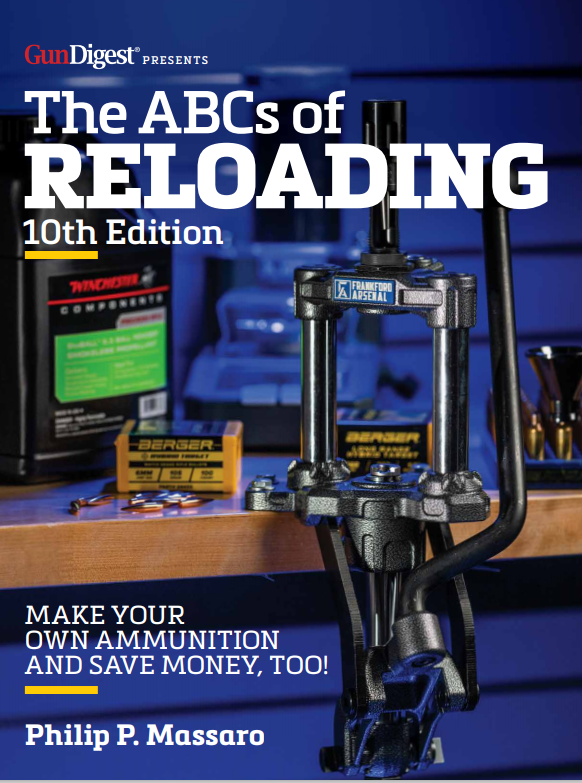
Reloading dies are the cartridge-specific tools used for resizing, flaring, bullet seating, and crimping. They’re screwed into the top of the reloading press and set at specific depths to give the exacting dimensions needed for proper functioning ammunition.
Most basic bottleneck rifle die sets will come with two dies: a full-length resizer and a seater. The full-length resizing die forms the entire cartridge, from base to mouth, to the acceptable SAAMI- or CIP-approved dimensions. The bullet seating die serves two purposes: It seats the bullet in the case to a specific depth, and it can be adjusted to roll the case mouth into the bullet’s crimping groove or cannelure, producing what is called a roll crimp. The roll crimp is desirable in the hard-kicking magnum rifle and pistol cartridges and is necessary on any straight-walled case that doesn’t headspace off the case mouth.
Straight-walled cartridge die sets also typically come with a flaring die, which opens up the case mouth like a bell to allow the bullet to be seated in the case without crumpling the case walls.
The wide selection of reloading dies can be dizzying. I’m not sure there is one brand or type I’m married to as, during my reloading career, I’ve probably used ones from nearly every manufacturer at one point in time or another. That includes defunct brands such as Herter’s, Pacific, and several custom-made ones. Among these, I’ve only had one defective set; the company is no longer in business, but the .300 H&H cases I was trying to resize wouldn’t function in the gun no matter what I did.
Redding Dies
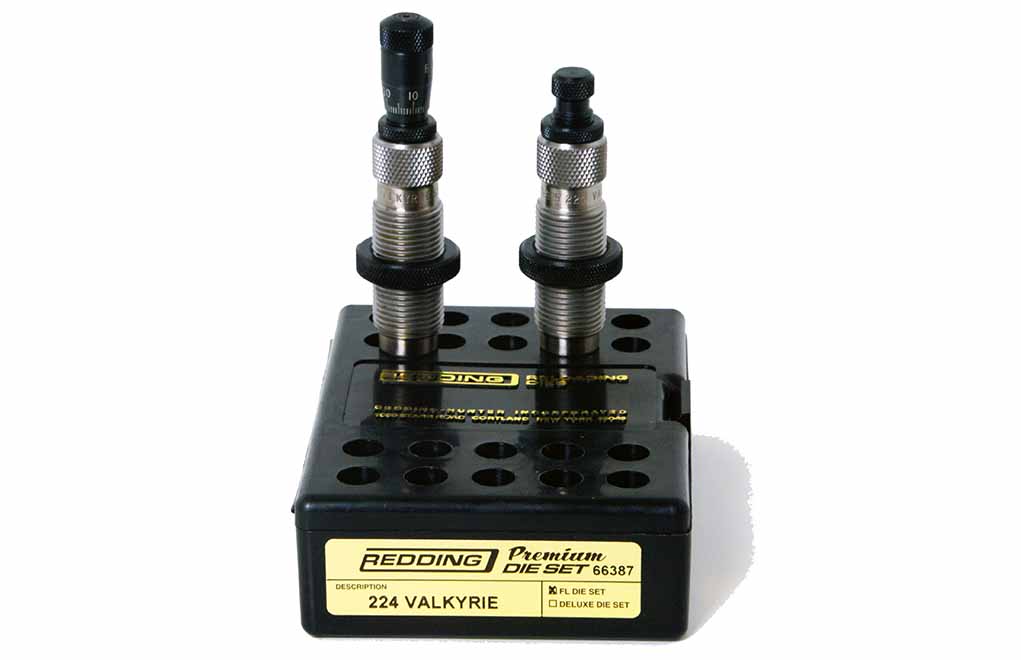
I try to buy the best dies I can afford, and sitting at the top of my list are those from Redding. Redding Reloading, from my home state of New York, has long been famous for producing products with exceptionally tight tolerances. Redding’s high-end dies are no exception, though costly.
Redding offers various levels of dies, and even the lower-priced standard sets are a worthy purchase. The components are very precisely made, and the surfaces are polished to a mirror finish. It’s been my experience that Redding dies are polished so well that extra attention needs to be paid to the proper application of lubricant to avoid case sticking. The Redding Elite die set includes the Type S Bushing full-length resizing die, which extends brass life by reducing the necks only as much as is needed before drawing it over the expander ball. That set also includes bushing neck-sizing dies. Redding’s micrometer-adjustable Competition seating die allows you to make quick, accurate, and predictable adjustments to the seating depth. These die sets are expensive, but the results make the price well worth it.
Redding’s Premium dies sets feature a standard full-length seating die, with a carbide expander ball and bullet seating micrometer. Redding builds its standard dies to the same tight specifications as its premium line, but it’s the small things that you’ll appreciate. The lock rings are blued, knurled steel and the set screw rests against a small lead shot instead of against the die body, so nothing gets scratched. I could spend the rest of my reloading days happily using Redding dies.
RCBS Dies
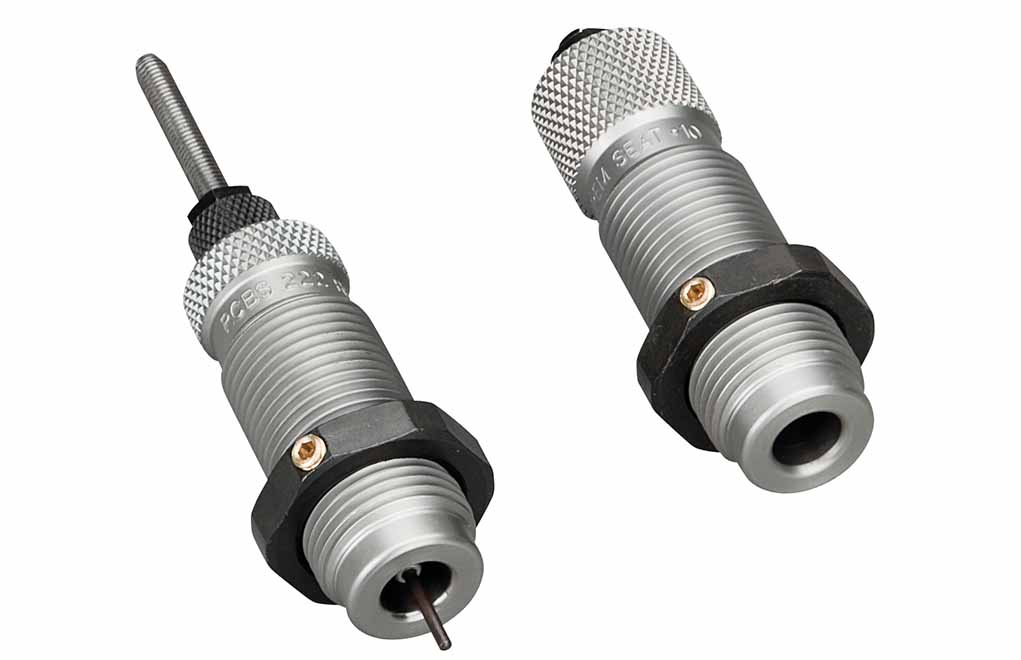
There were times, especially as a younger man, when a set of Redding dies were simply out of my financial reach. RCBS dies were the best I could do, and they were a smart purchase. The standard RCBS dies aren’t full of bells and whistles but are simple affairs that get the job done. I’ve loaded a lot of ammo on RCBS dies and continue to use them to this day.
RCBS basic sets have lock rings with wrench flats, and the seater plugs and decapping rods are held in place by small hex nuts. There are knurled rings at the top of the die bodies to grip when screwing the die into the press. Were I on a tight budget, I’d still look to the RCBS die sets to get the job done. They offer a full line of rifle and pistol dies and taper crimps, plus titanium carbide pistol dies that require no lubrication on the cases.
While the standard RCBS die set is probably the benchmark in the reloading world, RCBS has stepped up its game as of late. Its MatchMaster die sets are on par with the Redding stuff. Micrometer-adjustable seating dies with a window cutout in the body to drop the bullet onto the case mouth, full-length bushing resizing dies that will extend brass life — RCBS has met the demands of the modern reloader’s needs.
More Reloading From Phil Massaro:
- Choosing the Best Reloading Press for Your Needs
- Primers, First Stage of Ignition
- The Reloading Scale and Ammo Accuracy
- Reloading Manuals the Sacred Tomes of Reloading
- Gunpowder or Things That Make You Go Boom!
Hornady Dies
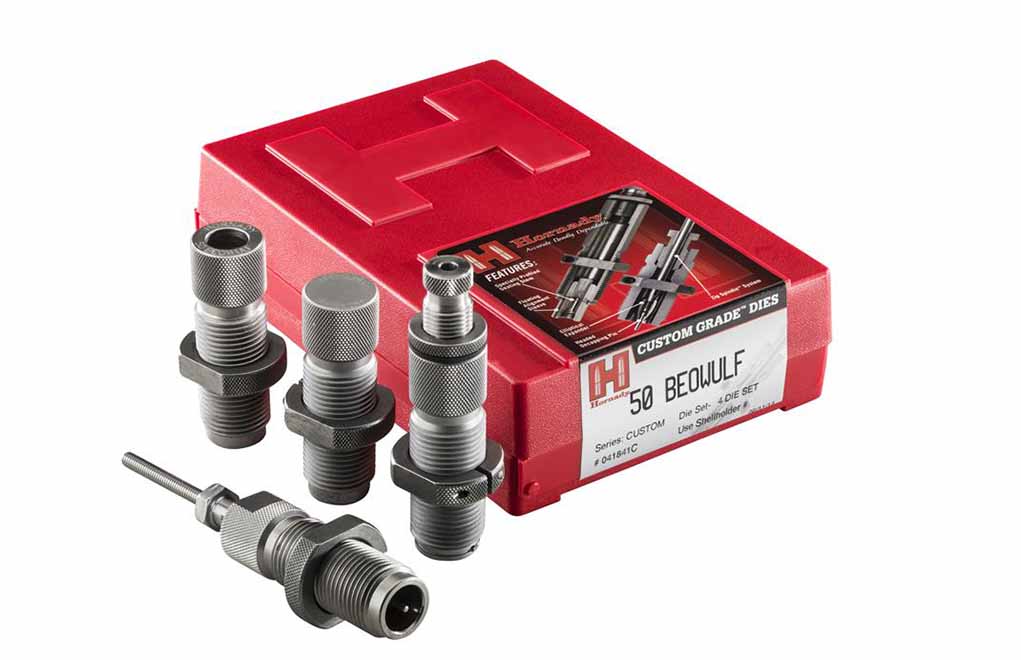
Hornady has a well-earned reputation for producing quality reloading products, and its reloading dies have some unique features that many prefer. I like Hornady’s Custom Grade dies, which include the New Dimension sizing and seating dies. Both use a knurled, split lock ring with two flats, so you can use an adjustable wrench if necessary. What’s more, the lock ring tightens via an Allen-head screw, which tightens the ring around the die body (rather than against the die threads). The sizing die features wrench flats as well, and both have knurled bodies for a positive grip when screwing the dies into the press body. The sizing die has an elliptical expander ball, which aids in the smooth sizing of your cases. The Zip Spindle makes large and small adjustments simple. The finely threaded spindle makes precise adjustments, yet increased pressure on the rod will move the spindle up or down for rough adjustments.
The seating die included in the set is not cartridge specific; instead, Hornady produces them for the entire range of each caliber. Hornady uses an inline bullet seating system, including a floating bullet alignment sleeve, to enhance concentricity. You can set the seating die for a roll crimp or taper crimp (depending on which model you purchase), and some sets include various seater plugs. Hornady provides a pair of extra decapping pins in the die box, which come in very handy should you break one.
The American Series dies from Hornady are more affordable and are constructed of hardened steel, polished to a smooth finish. The dies come with a shellholder of appropriate size, and Hornady includes basic reloading data. The three-die sets for straight-walled cases feature a resizing die with a titanium nitride resizing ring to eliminate the need for case lubricant. The American series is available in five standard rifle cartridges and four different dual-purpose handgun cartridges.
The Match Grade Hornady die sets include a bushing resizing die. Bushings are not included and are sold separately. The Microjust seating die in this set has the same features as the Custom Grade New Dimension seating die, but with a micrometer adjustment on its top, in .001-inch increments.
Hornady can also make you a set of custom dies, based on the chamber reamer drawing used for your rifle or derived from spent cases fired in your gun. Custom dies are an excellent option for those wildcatters who enjoy shooting their creations. It’s a costly process, but if you have an obscure or vintage firearm for which dies are nearly impossible to obtain, Hornady’s customization service can mean the difference between a functioning gun and a wall-hanger.
Hornady also offers the option of using its Lock-n-Load bushings with its presses, which locks the dies into the press with a simple turn, saving you the time spent screwing and unscrewing dies.
Lyman Dies
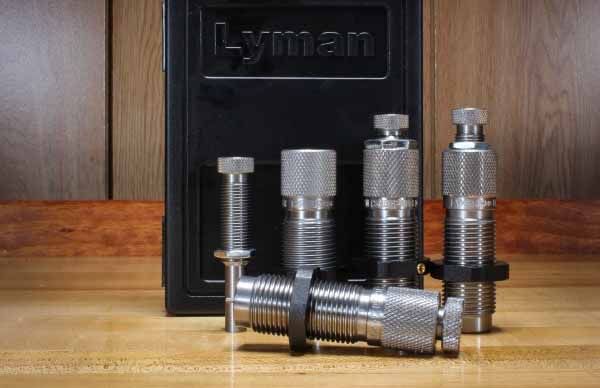
Lyman has long made excellent reloading dies and continues to do so. They are constructed of hardened, heat-treated steel, with the pistol cartridge dies featuring tungsten carbide sizing rings. Lyman’s three-die rifle sets give you flexibility. Lyman includes a full-length resizing die and a neck sizing die, along with a seating die. These die sets also include the appropriate shellholder and an Allen key to set the lock ring. (Lyman lock rings look remarkably like the RCBS lock ring.) The resizing dies use a threaded rod to hold the decapping pin and expander ball, locked in place via a small hex nut at the top of the die body. The Lyman seating die features a knurled seating plug, locking down with a small hex nut.
The Lyman dies’ replaceable decapping pins screw onto a one-piece rod and these slide into the expander ball. While the Lyman dies are relatively simple and lack the bells and whistles of some of the more complex models, they represent an excellent value to the beginning reloader. The simple design allows you to set up dies quickly and easily, ready to make top-performing ammo for a lifetime.
Lyman’s Premium Carbide 4 Die sets offer the traditional trio of resizing, flaring, and seating dies in a carbide setup that doesn’t require case lube. A taper crimp die is the fourth in the set.
Lee Dies

My first reloading experiences were with Lee products, as my Dad had a three-hole Lee turret press and a set of Lee dies for his .308 Winchester. Lee uses steel bodies with aluminum lock rings held in place with a rubber O-ring. These dies are a great value even if they don’t have other brands’ more expensive features. Though I much prefer a die body with a lock ring that won’t move, I’ve made a bunch of ammo using Lee equipment, resulting in some impressive accuracy from my guns.
Lee includes a shellholder with its die sets, and a plastic scoop of proper volume, as well as a chart depicting load data for the spectrum of bullets used in the chosen cartridge.
In Lee’s straight-walled cartridge three-die sets, the flaring die is a ‘Powder-Thru’ design, so you can insert a powder funnel in the top of the die to charge cases. The company’s Factory Crimp Die has a place of honor among many reloaders, as it operates differently than the standard roll or taper crimps. The die creates a segmented crimp of the end of the case mouth and is safe to use even with bullets lacking a cannelure. It’s very popular among reloaders, even those who prefer the more expensive brands. The theory is that the crimp created by this die equalizes the pressure needed to get the bullet moving from the case to the barrel, and therefore helps to equalize velocities.
I’ve used a Lee Factory Crimp Die with good results in the past and will continue to do so. I feel this particular product is the best in the Lee lineup. Many reloaders appreciate the price advantage of the Lee dies. Still, I usually lean toward the RCBS stuff for a budget-friendly choice, though every reloader should try the Factory Crimp.
Editor's Note: This article is an excerpt from The ABCs of Reloading, 10th Edition by Phil Massaro, on sale at GunDigestStore.com.

Next Step: Get your FREE Printable Target Pack
Enhance your shooting precision with our 62 MOA Targets, perfect for rifles and handguns. Crafted in collaboration with Storm Tactical for accuracy and versatility.
Subscribe to the Gun Digest email newsletter and get your downloadable target pack sent straight to your inbox. Stay updated with the latest firearms info in the industry.

![Best Concealed Carry Guns In 2025 [Field Tested] Wilson Combat EDC X9S 1](https://gundigest.com/wp-content/uploads/Wilson-Combat-EDC-X9S-1-324x160.jpg)


![Best 9mm Carbine: Affordable PCCs [Tested] Ruger Carbine Shooting](https://gundigest.com/wp-content/uploads/Ruger-Carbine-Shooting-100x70.jpg)
![Best AR-15: Top Options Available Today [Field Tested] Harrington and Richardson PSA XM177E2 feature](https://gundigest.com/wp-content/uploads/Harrington-and-Richardson-PSA-XM177E2-feature-100x70.jpg)

If you are shooting for accuracy, try a Mighty Armory die. They are fast becoming the favored die of many professional competitors. And 100% USA made.